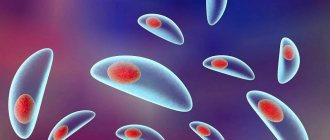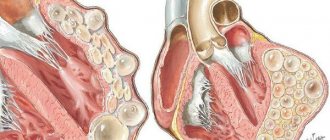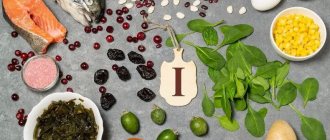January 14, 2011
How is nutrition structured for weight loss in case of obesity, what food should you give up, and what should be left for normal functioning of the body.
It is necessary to fight excess weight. It not only makes a person unattractive, but is a serious risk factor for the development of a huge number of diseases. Including such poorly treatable and potentially fatal ones as heart attack with stroke or even cancerous tumors. However, even if you are truly overweight, the choice of diet for weight loss must be taken very responsibly. The common belief that in order to lose excess weight it is enough to eat almost nothing for a while or even go hungry is a misconception. After all, the goal is not only to lose weight, but also not to harm your health.
How is a diet designed for obesity?
Overweight or obese?
Obesity is usually diagnosed with a body mass index (BMI) of 30 or more. You can find out your BMI yourself using our calculator. And what other formulas there are for determining a healthy weight are described in a special material.
Many diets have been developed for the treatment of obesity, but the main principle of traditional diet therapy is a sharp reduction in calorie intake, proportional to excess of normal body weight. This indicator is calculated individually for each nutritionist’s client, but usually with severe excess weight, the number of calories is reduced by an average of 40 percent of the daily energy requirement.
UZ "Mogilev City Emergency Hospital"
In case of overweight and obesity, it is necessary to reconsider the calorie content of food and diet. You need to analyze what you eat from the moment you wake up in the morning until you go to bed in the evening, including snacks and drinks.
You can reduce the caloric content of food by changing the set of foods you eat or the size of portions.
If you do not take into account the calorie content of foods, even on a “healthy” diet, weight will not decrease.
Calorie needs can be checked with a doctor, and can be calculated using special programs that can be found on the Internet (for example, FatSecret). Individual daily caloric intake is calculated using formulas taking into account gender, age, body weight and level of physical activity. It is convenient to use special calorie counting programs that can be installed on your smartphone.
It is necessary to create such an energy deficit that will ensure a decrease in body weight by 0.5-1 kg per week. To do this, the calorie content of food should be 500-1000 kcal less than the body's energy expenditure. In this case, the daily caloric intake for women should be at least 1200 kcal/day, for men - 1500 kcal/day.
It is recommended to divide the daily calorie intake into 5-6 meals per day. It is important not to skip meals during the day; skipping the next meal contributes to overeating.
Portions should be weighed and not determined by eye. If you want to eat, but the calories have already been eaten, drink water.
We should strive to eat voluminous, non-calorie foods (all varieties of cabbage, zucchini, eggplant, radishes, radishes, celery, legumes, peppers, mushrooms, herbs, lettuce, bran, whole grain porridge), which fill the stomach and give a feeling of fullness.
Do not add sauces to dishes. Food should not be fried, but baked or stewed without adding oil, because... oil (including vegetable oil) contains a lot of calories. For example, 1 tablespoon of vegetable oil contains approximately 108 calories. Many people do not measure out a portion of vegetable oil, but pour it “by eye” directly from the bottle, as a result of which the calorie content of even a light vegetable salad can greatly increase. Vegetable oil should be dosed with a teaspoon or tablespoon.
It is important to remove unaccounted snacks that are not counted but contain a lot of calories (seeds, nuts). To avoid temptation, it is better that these products should not be at home at all. There is no need to put out bowls of sweets, cookies, etc., or buy food for future use.
It is also important to limit drinks that contain calories (juices, kvass, dairy products). Milk, kefir, etc. contain calories, so they can and should be consumed, but take into account the calorie content. This is food, not drink.
A separate problem is dinner. For many people, it constitutes their main meal of the day. This regime needs to be reconsidered. If you overeat at night, find another activity instead of a late dinner (walk, etc.). But you shouldn't go to bed hungry either. Before going to bed, you need to eat a carbohydrate-free meal (cabbage or herb salad without oil, mayonnaise and sour cream, cucumbers). If you go to bed completely hungry, the liver may begin to “throw out glucose” and as a result we will get high blood glucose levels in the morning. Normally this does not happen, but in diabetes, carbohydrate metabolism is unbalanced.
There are many nutritional systems aimed at reducing body weight: the plate rule, the traffic light nutritional rule, the Zimbabwean hand rules, etc. There is information about all these systems in the literature and on the Internet. You can choose what suits you. The essence of all these systems is the same: reducing the calorie content of food.
Formalization of nutrition is very important. Meals should have a clear beginning and end. Don't eat while watching TV, reading, etc. Distraction can lead to “unconscious” overeating and taking in excess calories. You need to eat at the table, putting away your gadgets and turning off the TV. There is no need to eat from packages, pans, etc., finish eating after the children, etc.
If you are eating outside the home, you need to think about what you will eat in advance. It’s convenient to take containers with pre-packaged food to work.
Menu planning issues.
Patients often ask to create a menu for them. In the Republic of Belarus, there are no nutritionists in government institutions who must create an individual menu for each patient. The responsibilities of endocrinologists, therapists, and gastroenterologists also do not include menu preparation. Creating a custom menu is a time-consuming job. It is no coincidence that the services of private nutritionists are quite expensive.
The high cost of private nutritionist services is an integral part of treatment. If a person paid a lot of money for this menu, then there is a chance that he will follow it.
However, each person can create their own menu.
To do this you need:
- Determine your daily calorie intake (you can check this question with your doctor).
- Make a list of foods that you usually eat (excluding non-recommended foods from it, taking into account the rules of healthy eating). You can use the section “Tables with product composition”. Please note that carbohydrates should make up 50-55%, fats 30-35%, proteins 10-15% of daily calories.
- In the list next to each product, write its calorie content (the calorie content of any product can be found on the Internet).
- Calculate how much of which product you can eat per day based on calorie content.
- Distribute foods over 3-6 meals, focusing on your lifestyle.
Basic principles for losing weight:
1. Reducing the calorie content
of the diet to 1800 kcal and below, calculated by a specialist based on the person’s initial weight.
2. Limiting fast carbohydrates in the menu - especially sugar and white flour products (pasta, pastries, white bread) - the main suppliers of energy
that are easily stored in fat.
3. Limit animal fats
by 50 percent.
But this does not mean that the diet becomes fat-free. Animal fats in the diet are replaced by vegetable fats, which can activate the process of the body using up its own fat reserves. 4. Creating a feeling of satiety
by increasing the proportion of low-calorie but high-volume foods in the diet - raw vegetables, fruits, whole grain products.
5. Small meals - up to six times a day
- help fight hunger.
The daily ration is simply divided into six equal parts, which are eaten at regular intervals. 6. Refusal of
foods that stimulate the appetite - spices, herbs, savory snacks, smoked meats and pickles.
7. Limiting the amount of salt to five g per day and normalizing the drinking regime
- up to 1.5 liters per day, mainly clean drinking water.
General principles of nutrition
Goals of a therapeutic diet for obesity:
- weight loss;
- normalization of lipid metabolism;
- regulation of water-salt balance.
Basic Rules:
- emphasis on plant fiber and dietary fiber;
- fractional meals 5-6 times a day;
- It is forbidden to visit fast food establishments: it is strongly recommended to prepare all dishes with your own hands at home from high-quality products;
- if you salt food, then only after cooking, in your own plate;
- replacing sugar with sweeteners;
- exclusion of fried, mashed, chopped foods;
- maximum daily calorie content - 1,900 kcal;
- limiting spices;
- portions should be minimal;
- cooking methods - boiling, stewing, baking;
- daily increase in protein content (up to 100 g), reduction in fat (up to 80 g, of which 40 g are vegetable), moderate amount of carbohydrates (up to 200 g).
If the patient follows a therapeutic diet in a hospital setting, the caloric content of the daily diet, with the permission of the doctor, can be reduced to 800 kcal.
Therapeutic diet
When treating obesity, nutritionists usually use diet No. 8
, the calorie content of which they can increase or decrease by eliminating certain foods in the diet.
| Products | It is forbidden | Can |
| Bread | White, all baked goods | Black, protein - up to 150 g per day |
| Soups | Meat, fish and mushroom, all strong broths | Soups based on vegetable broths, weak broths made from lean meat |
| Meat | Pork, goose, duck, lamb, fatty chickens, all smoked meats and sausages | Lean beef, rabbit, fat-free chicken, boiled or stewed |
| Fish | All fatty varieties, smoked or fried | Low-fat boiled or steamed fish, seafood |
| Vegetables | Potatoes, beets, carrots and other vegetables with a high glycemic index | Cabbage, leafy vegetables, radishes, cucumbers, tomatoes, greens - raw or baked, seaweed |
| Cereals, legumes, pasta | Pasta | Cereals, beans or lentils as sources of essential amino acids - instead of bread. |
| Egg dishes | Fried omelettes or fried eggs | Boiled, steamed |
| Dairy | Hard cheeses, margarine, sour cream, full-fat milk and cream | Low-fat milk, kefir, yogurt, cottage cheese |
| Fruits | Sweet fruits with a high glycemic index | Sour and sweet and sour varieties of fruits and berries up to 200 g per day |
| Beverages | Compotes, jellies and nectars with sugar, sweet soda, sweet juices | Coffee or tea without milk and sugar, juices from sour fruits and berries, mineral water |
| Fats | Lard, margarine, spreads | Butter and vegetable oils - 20 g per day only for cooking |
Sample menu for the week
If it is not possible to take into account all the nuances of the disease and use the help of specialists, you can always take a universal menu for the week. It is suitable for the treatment of any type of obesity. It is based on table No. 8 according to Pevzner.
Menu for 7 days
Diets for obesity are therapeutic, since their main goal is to cure a person from this disease. But at the same time, it is necessary to use other methods - exercise, take medications that block appetite and normalize digestion. Surgery may even be necessary. In the fight against excess weight, you need to use all known methods.
What to remember
Treatment of obesity involves a low-calorie diet combined with exercise.
Despite the fact that when losing weight you have to give up many foods, your diet must contain a sufficient amount of protein, fat and foods containing a lot of fiber. For individual recommendations, it is best to contact a nutritionist. Tags:
- Diets
- Diet
- Overweight
- Weight loss
- Therapeutic diets
• To leave a comment you must be an authorized user
- Usavel Fitness Sweets are the most popular variety of healthy probiotic candies. The most useful of all types. There are 2 types: with goji berries and with blueberries. In addition to the indisputable fact that these berries are extremely beneficial for the whole body, fitness fruits are also created to strengthen the immune system and prevent dysbacteriosis, and also contain stevioside, which is the most useful of all sugar substitutes. Suitable for adults: dietary food (does not contain sugar and fat), diabetic nutrition, sports nutrition (has a restorative effect when playing sports). If you are interested in our products, then you can find out more on the website: biosynergy[dot]ru or call by phone (calls within the Russian Federation are free)
- Usavel Immunofets are no less useful probiotic candies for immunity and the prevention of dysbiosis; in addition, they contain fructose, which is sweeter than sugar, but does not have the harmful effects of sugar. There are seven types: strawberry, raspberry, blueberry, blackcurrant, cherry, lime and milk flavor. Suitable for children and adults who have restrictions on sugar intake, and those who are on various diets and dream of sweets.
- Usavel In our opinion, the best solution is a combination of sweets and healthy supplements. Children and adults, when eating candy, additionally receive beneficial bifidobacteria and lactobacilli, as well as microelements to increase the body's immunity. We present to you a line of healthy food products - “Biofet”, “Immunofet”, “Fitnessfet” containing probiotics and extracts of delicious and healthy berries and fruits. Biofets are healthy probiotic candies that strengthen the immune system and are also used to prevent dysbacteriosis. The product line includes three types: banana, blueberry and milk flavor. Suitable for children and adults who want to strengthen their immunity and not think about dysbiosis while consuming delicious sweets.
- Usavel Healthy candies for the whole family! How often do you remember to eat healthy? We all think about eating healthy, but don't stick to it because it may not taste as good as other less healthy foods that fill grocery store shelves. Parents often think that they should feed their children healthy food to avoid health problems in the future. After all, we all know about the dangers of food that we buy for the joy of children. But the whole problem lies in the small range of products, high cost and poor taste.
- kurashko I have been on many diets, but the most optimal ones, where the weight really goes away, are the fermented milk diet, the Mayo Clinic diet... and count calories... the most important thing is to drink vitamins
- efremenko Eat less and most importantly exercise.
Individual cases
In addition to generally accepted postulates and dietary tables, specialists necessarily focus on special, individual cases of obesity. Each of them requires minor but important changes in diet:
- with the visceral type, it is prohibited to include fats and fast carbohydrates in the menu;
- for fatty liver, dietary table No. 5 is prescribed;
- if women are overweight, the consumption of protein foods can be reduced, while men cannot do this in any way: their diet must include lean meat every day;
- if excess weight is accompanied by diabetes, it is possible to use not only table No. 8, but also No. 9;
- in case of obesity in children, a special menu is drawn up, which necessarily contains a lot of plant fiber and carbohydrates (they need energy), a special role is given to delicious desserts with a minimum amount of sugar;
- for heart obesity, table No. 10 is recommended;
- for abdominal pain, the DASH diet is most often prescribed, which wisely combines lean meat, fish, vegetables, fruits and low-fat dairy products in the diet;
- A diet for overweight adolescents during puberty is developed very carefully: it must be balanced and avoid deficiencies of vitamins and microelements.
These points must be taken into account when choosing a power system.
Causes of obesity
The causes of obesity can be divided into 2 large groups: exogenous (dietary) and endogenous (morbid) obesity.
These forms of obesity differ from each other precisely in the reason that causes increased fat deposition. If nutritional obesity occurs due to excessive intake of calories from food due to appetite, eating habits, and poor nutrition, then morbid obesity is a disease based on a violation of metabolic processes and hormonal regulation of both eating behavior and fat metabolism.
Types of obesity:
There are visceral (also known as abdominal, also known as central) obesity and peripheral obesity. Often the first type of fat deposition is morbid in nature, if you have such obesity, losing weight will be a difficult task. Internal obesity is characterized by the deposition of fat mainly around the internal organs, liver, heart, stomach, pancreas. Abdominal obesity occurs most often, and while in women fat usually accumulates mostly under the skin, in men it is deposited in the area of internal organs.
Symptoms of obesity:
Signs of obesity are, of course, weight gain that is beyond what is normal for your height, gender, and age. Obese patients usually have other complaints, the severity of which depends on the degree of obesity.
As it progresses, shortness of breath, pain in the legs and back appear, the joints of the limbs and venous system suffer, and swelling appears. In severe cases, when the disease persists for a long time, atherosclerosis and hypertension are common, which become the killers of obese patients.
MONDAY
Breakfast: millet porridge with pumpkin
Lunch: beetroot soup; meatballs with buckwheat (1-2 pieces will be enough)
Afternoon snack: baked apples with cottage cheese
Dinner: salmon with lemon in paper + vegetables of your choice
Nutritionist's comment:Porridge is an ideal breakfast dish. In the morning, our body needs carbohydrates; they will provide energy for the first half of the day and give strength. And pumpkin will enrich your breakfast with vitamins, it is especially rich in vitamin A. Lunch should be varied; it is one of the key meals. Include vegetables, meat, and grains in your lunch. Even during the period of weight loss, you should not forget about desserts. Let them be light and definitely healthy - apples with cottage cheese are a great option. As a side dish for dinner, I would offer fresh vegetables - lettuce, cherry tomatoes and sweet peppers. Or you can steam vegetables, cauliflower or broccoli are suitable. Red fish is an excellent source of Omega-3 fatty acids; they are necessary for the visual organs, the central nervous system and help reduce “bad” blood cholesterol. |










